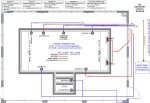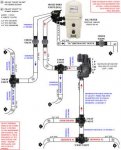We recently retired to live in Philippines and will be building a new house, starting construction hopefully in January of 2018. Our architect is finishing up the house plans while I complete the pool technical design. Below is the equipment shopping list for our future 13.5 x 30 ft indoor IG liquid chlorine pool and drawings I made to explain our vision to the pool builder. We already obtained some quotes but they are almost useless as they don't want to share any details with us for fear we will not use them to build, so I have to do my own detailed plumbing and structural design first. The project is in Philippines but all equipment will be ordered (by me) and shipped from USA because letting the pool builder supply it will cost 3-4 times as much. Both suction and return lines will all be 2.0 inch Schedule 40 PVC pipe because the availability of 2.5 or 3.0 inch PVC pipe and fittings are more difficult to find. However, the return and dedicated pressure lines will terminate in the pool as 1.5 female threaded pipe. I would appreciate any advice. Thanks -Mel
Pentair 180008 FNS Plus 48 Sq. Ft. Vertical DE Pool Filter, 96 GPM (qty 1)
Pentair 261152 2.0-Inch Threaded Multiport Valve For FNS Plus DE Filter (qty 1)
Hayward SP2303vsp Max-Flo VS Variable-Speed Pool Pump, 230 Volt, Single Phase, 2.0 Inch Connect, Maximum of 80 GPM with 2.0-Inch Pipes or 110 GPM with 2.5-Inch Pipes (qty 1)
Pentair 500120 StarGuard Drain, 8-Inch, White, 2-Pack, ABS, 72-GPM, Installed In Pool Wall. (qty 1 – Because Product Sold As 2-Pack)
Pentair 506300 PVC 2.0 Inch Slip-Port Bermuda Skimmer, White (qty 2)
--- Equalizer Port is Permanently Sealed With Both Screw-In Plug and Slip Cap.
Pentair T40FW Autofill (Automatic Water Leveler) With Fluidmaster Valve (qty 1)
Jandy 4717 3-Port 2.0” To 2.5” Neverlube Valve, CPVC (qty 4)
Jandy 7305 180-Degree 2.0” To 2.5” Inch Check Valve, CPVC (qty 3)
Hayward SP1056 Hydrostatic Relief Valve, White, Installed In Main Drain Port. (qty 2)
Hayward SP1055 Relief Valve Suction Outlet Collector Tube For Hydrostat. (qty 2)
Intermatic T104R 230v Mechanical Timer Switch With Outdoor Metal Case. (qty 2)
--- First Timer Wired To Hayward Filter Pump
--- Second Timer Wired To Stenner Liquid Bleach/Chlorine Pump
Intermatic PS3000 Surge Protector, Installed In Electrical Service Panel. (qty 1)
Stenner 45MPH10-B 220v/60Hz Liquid Chlorinator Pump With Hoses & Connectors
--- Container Drums Purchased & Supplied Locally
Hayward SP1026 Threaded MPT Safety Grate for 1.5" Return Fitting (qty 5)
--- Fits Threaded Female 1.5 Inch PVC Return & Pressure Lines.
Polaris 360 Pressure Side Cleaner (No Booster Pump Required)
Stainless Grab Rails
--- One Set (2 Pieces) of A-Shape
--- One Set (2 Pieces) of P-Shape
Bronze Anchors (For Install of Stainless Handrails)
--- S.R. Smith AS-100B 4-Inch Anchor for 1.90-Inch Outer Diameter Tubing (qty 8)
TFP-100 Test Kit (qty 1)
Weld-On 11890 Gray 724 Heavy-Bodied CPVC Professional Industrial-Grade Cement, Medium-Setting, Low-VOC
Spears Mfg Brand 2.0 Inch PVC “Sweep” 90-Degree Elbow, Part # 406-020s (qty 25)
https://www.dropbox.com/s/zvjxgsuyf6t3p81/Image29.jpg?dl=0
https://www.dropbox.com/s/7jzli8osmeuqkt8/POOL LAYOUT (EQUIPMENT).png?dl=0
https://www.dropbox.com/s/b0uaeuumor9sbdc/POOL LAYOUT (PLUMBING).png?dl=0
https://www.dropbox.com/s/xlendrofuojetn1/POOL LAYOUT (SIDE VIEW).png?dl=0
Pentair 180008 FNS Plus 48 Sq. Ft. Vertical DE Pool Filter, 96 GPM (qty 1)
Pentair 261152 2.0-Inch Threaded Multiport Valve For FNS Plus DE Filter (qty 1)
Hayward SP2303vsp Max-Flo VS Variable-Speed Pool Pump, 230 Volt, Single Phase, 2.0 Inch Connect, Maximum of 80 GPM with 2.0-Inch Pipes or 110 GPM with 2.5-Inch Pipes (qty 1)
Pentair 500120 StarGuard Drain, 8-Inch, White, 2-Pack, ABS, 72-GPM, Installed In Pool Wall. (qty 1 – Because Product Sold As 2-Pack)
Pentair 506300 PVC 2.0 Inch Slip-Port Bermuda Skimmer, White (qty 2)
--- Equalizer Port is Permanently Sealed With Both Screw-In Plug and Slip Cap.
Pentair T40FW Autofill (Automatic Water Leveler) With Fluidmaster Valve (qty 1)
Jandy 4717 3-Port 2.0” To 2.5” Neverlube Valve, CPVC (qty 4)
Jandy 7305 180-Degree 2.0” To 2.5” Inch Check Valve, CPVC (qty 3)
Hayward SP1056 Hydrostatic Relief Valve, White, Installed In Main Drain Port. (qty 2)
Hayward SP1055 Relief Valve Suction Outlet Collector Tube For Hydrostat. (qty 2)
Intermatic T104R 230v Mechanical Timer Switch With Outdoor Metal Case. (qty 2)
--- First Timer Wired To Hayward Filter Pump
--- Second Timer Wired To Stenner Liquid Bleach/Chlorine Pump
Intermatic PS3000 Surge Protector, Installed In Electrical Service Panel. (qty 1)
Stenner 45MPH10-B 220v/60Hz Liquid Chlorinator Pump With Hoses & Connectors
--- Container Drums Purchased & Supplied Locally
Hayward SP1026 Threaded MPT Safety Grate for 1.5" Return Fitting (qty 5)
--- Fits Threaded Female 1.5 Inch PVC Return & Pressure Lines.
Polaris 360 Pressure Side Cleaner (No Booster Pump Required)
Stainless Grab Rails
--- One Set (2 Pieces) of A-Shape
--- One Set (2 Pieces) of P-Shape
Bronze Anchors (For Install of Stainless Handrails)
--- S.R. Smith AS-100B 4-Inch Anchor for 1.90-Inch Outer Diameter Tubing (qty 8)
TFP-100 Test Kit (qty 1)
Weld-On 11890 Gray 724 Heavy-Bodied CPVC Professional Industrial-Grade Cement, Medium-Setting, Low-VOC
Spears Mfg Brand 2.0 Inch PVC “Sweep” 90-Degree Elbow, Part # 406-020s (qty 25)
https://www.dropbox.com/s/zvjxgsuyf6t3p81/Image29.jpg?dl=0
https://www.dropbox.com/s/7jzli8osmeuqkt8/POOL LAYOUT (EQUIPMENT).png?dl=0
https://www.dropbox.com/s/b0uaeuumor9sbdc/POOL LAYOUT (PLUMBING).png?dl=0
https://www.dropbox.com/s/xlendrofuojetn1/POOL LAYOUT (SIDE VIEW).png?dl=0
Attachments
Last edited:






 The album link does not work but
The album link does not work but 

